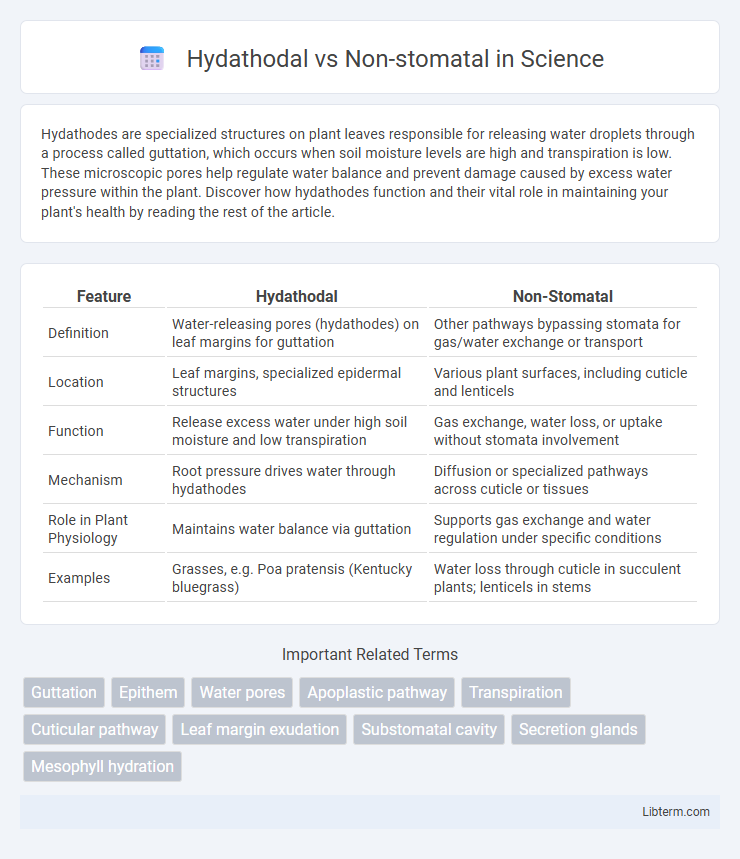Hydathodes are specialized structures on plant leaves responsible for releasing water droplets through a process called guttation, which occurs when soil moisture levels are high and transpiration is low. These microscopic pores help regulate water balance and prevent damage caused by excess water pressure within the plant. Discover how hydathodes function and their vital role in maintaining your plant's health by reading the rest of the article.
Table of Comparison
| Feature | Hydathodal | Non-Stomatal |
|---|---|---|
| Definition | Water-releasing pores (hydathodes) on leaf margins for guttation | Other pathways bypassing stomata for gas/water exchange or transport |
| Location | Leaf margins, specialized epidermal structures | Various plant surfaces, including cuticle and lenticels |
| Function | Release excess water under high soil moisture and low transpiration | Gas exchange, water loss, or uptake without stomata involvement |
| Mechanism | Root pressure drives water through hydathodes | Diffusion or specialized pathways across cuticle or tissues |
| Role in Plant Physiology | Maintains water balance via guttation | Supports gas exchange and water regulation under specific conditions |
| Examples | Grasses, e.g. Poa pratensis (Kentucky bluegrass) | Water loss through cuticle in succulent plants; lenticels in stems |
Introduction to Hydathodal and Non-stomatal Pathways
Hydathodal and non-stomatal pathways regulate water and gas exchange in plants through distinct mechanisms; hydathodes are specialized structures at leaf margins that facilitate guttation by releasing excess water. Non-stomatal pathways include cuticular transpiration and diffusion through lenticels, contributing to water loss independently of stomata. Understanding these pathways is essential in studying plant water relations and responses to environmental stress.
Definition of Hydathodal Openings
Hydathodal openings, also known as hydathodes, are specialized structures located at the margins or tips of leaves that facilitate guttation by exuding water droplets. Unlike stomata, which regulate gas exchange and transpiration via dynamic openings controlled by guard cells, hydathodes are permanently open pores connected to xylem vessels, allowing the release of xylem sap under root pressure. These non-stomatal openings play a crucial role in maintaining water balance, especially during conditions of high soil moisture and low transpiration rates.
Understanding Non-stomatal Pathways
Non-stomatal pathways refer to water loss mechanisms in plants that occur independently of stomatal openings, primarily through the cuticle and lenticels. These pathways are critical in drought stress scenarios where stomatal closure limits transpiration yet cuticular transpiration and other non-stomatal water losses continue. Understanding non-stomatal pathways enhances insight into overall plant water regulation, aiding in the development of drought-resistant crop varieties with improved water use efficiency.
Structural Differences Between Hydathodes and Stomata
Hydathodes are specialized structures at the leaf margins or veins that facilitate guttation, consisting of open pores without guard cells, whereas stomata are microscopic pores primarily on the leaf surface controlled by guard cells to regulate gas exchange. Hydathodes have a water-soaked tissue called epithem beneath the pore, aiding water secretion, while stomata lack this tissue and feature subsidiary cells supporting guard cell function. The non-motile nature of hydathode pores contrasts with the dynamic opening and closing mechanism of stomata, reflecting their distinct structural adaptations and physiological roles.
Functional Roles in Plant Water Regulation
Hydathodal water loss occurs through hydathodes at leaf margins, aiding in guttation and maintaining root pressure under high soil moisture conditions. Non-stomatal water loss primarily involves cuticular transpiration, contributing to water regulation when stomata are closed during drought stress. Together, these processes balance internal water status, ensuring optimal hydration and metabolic function in plants.
Mechanisms of Guttation via Hydathodes
Hydathodes facilitate guttation by actively secreting water through specialized pores at leaf margins, driven by root pressure when soil moisture is high and transpiration is low, distinguishing this process from non-stomatal water loss methods such as cuticular transpiration. The mechanism involves the movement of xylem sap through the vascular system to hydathodes, where water is released as droplets, enabling plants to eliminate excess moisture and minerals. Unlike stomatal regulation, hydathodal water release occurs passively without guard cell control, playing a crucial role in maintaining plant water balance under specific environmental conditions.
Non-stomatal Water Loss: Processes and Examples
Non-stomatal water loss occurs through the cuticle and lenticels, bypassing the stomata and contributing significantly in conditions where stomata are closed, such as drought or high temperature stress. Processes like cuticular evaporation and lenticular transpiration facilitate this water loss, with the cuticle's permeability and environmental factors playing crucial roles. Examples include water loss in succulent plants with thick cuticles and fruit surfaces, highlighting the importance of non-stomatal pathways in plant water regulation.
Comparative Importance in Plant Physiology
Hydathodal transpiration occurs through specialized structures called hydathodes and is crucial for guttation and nutrient exudation, while non-stomatal transpiration involves water loss through the cuticle and lenticels, significantly affecting water use efficiency under stress conditions. The comparative importance lies in hydathodal transpiration's role in maintaining root pressure and facilitating nutrient movement, contrasting with non-stomatal pathways that dominate during stomatal closure and drought, influencing overall plant water balance. Understanding these processes provides insights into optimizing irrigation strategies and improving drought resistance in crop plants.
Relevance in Environmental Stress Adaptation
Hydathodal and non-stomatal pathways play distinct roles in plant responses to environmental stress, with hydathodal transpiration facilitating water and ion release under high humidity conditions, aiding in osmotic balance. Non-stomatal transpiration, involving cuticular and lenticular evaporation, becomes critical during drought or high-temperature stress, reducing water loss when stomata are closed. Understanding the differential regulation of these pathways informs crop resilience strategies against abiotic stresses such as salinity, heat, and water deficit.
Future Research Directions and Applications
Future research on hydathodal and non-stomatal pathways will explore the molecular mechanisms regulating water and solute movement in plants, aiming to enhance drought tolerance and nutrient uptake efficiency. Advanced imaging techniques and genomic tools can elucidate the differentiation between hydathodal secretion and non-stomatal transpiration under varying environmental stresses. Leveraging these insights may lead to the development of crop varieties with optimized water use efficiency and resilience against climate change-induced stressors.
Hydathodal Infographic

 libterm.com
libterm.com